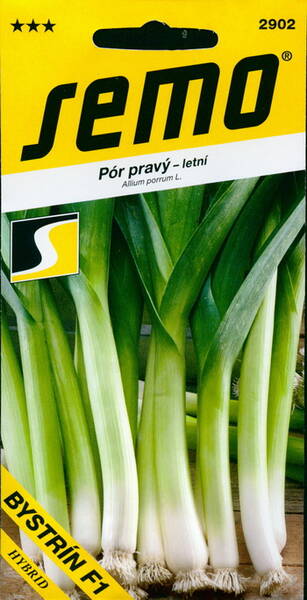A leek with a long white shaft for early July harvest (in Central Europe conditions) also suitable for fields covering by row cover.
BYSTRIN has showed very long field life - we can keep it on the field until autumn. The plants are very tall with light green and very upright leaves.
BYSTRIN is very resistant to high temperatures and lodging.
- Growing period 75 days (from planting to time of first possible harvest in Central Europe)
- Length/diameter of the white shaft 45/3 cm
- Leaf color light green.

Preparing leek seeds for sowing.
Since dry seeds germinate slowly (in 12-18 days), it is recommended to soak and germinate them. To do this, the seeds are kept in water at room temperature for 24 hours. Then they are placed on a damp cloth and germinated.
Growing seedlings.
In the climatic conditions of Estonia, it is recommended to grow leeks as seedlings. Onions are sown on March 15-20.
Before sowing, the seeds are kept in hot (+50°C) water for 20-25 minutes, then they are washed and soaked in a damp cloth for 5-7 days.
After this, the seeds are slightly dried and sown in boxes or a greenhouse. Leek seedlings are grown in low boxes filled with light humus soil.
The soil is lightly tamped, watered abundantly, and then the seeds are sown. The crops are not thickened, the seeds are sown at a distance of 2x2.5 cm.
When growing leek seedlings, you need to monitor the soil moisture and air temperature. During the day, it is advisable to maintain the temperature at +18+20°C, at night +14+15°C.
After 50-55 days, the seedlings are ready for planting. Before planting, shorten the leaves and roots by 1/3.
If the soil in the box was fertile enough, then caring for the seedlings is reduced mainly to abundant watering (but over-watering is unacceptable).
Seedlings aged 50-60 days are planted in late April - early May. Before planting, the seedlings must be hardened:
the boxes with plants are thoroughly watered and left for 2-3 days in the open air, in a place protected from wind and direct sunlight.
Cold snaps and even light frosts are not terrible for leeks. Leeks tolerate transplantation well.
Preparing a plot and planting leeks in the ground.
Leeks are a cold-resistant plant, but very demanding of soil fertility and moisture. In mild winters, under a thick snow cover, they can successfully overwinter in beds.
Leeks are very responsive to fertilizers. Organic fertilizers are applied in the fall when preparing the plot, mineral fertilizers - in the spring and summer when feeding.
Leeks are a moisture-loving plant; leaf growth stops during drought. In addition, a long-term lack of moisture affects the taste of the product.
Leeks are grown by direct sowing of seeds into the ground, with thinning, or through seedlings.
In the temperate climate zone, a commercial harvest of leeks is guaranteed to be obtained only through seedlings. The sowing time is selected depending on the timing of the harvest.
In the spring, the bed intended for leeks is well fertilized with organic fertilizers.
For 1 sq. m add a bucket of humus or compost, add 2 liter jars of wet sawdust, a jar (0.5 l) of ash.
Of the mineral fertilizers, add 2 tablespoons of nitrophoska and a teaspoon of urea. Dig everything well to a depth of 20-22 cm.
Plant leeks in well-watered furrows 12 cm deep with a pink solution of potassium permanganate.
Rows are placed at a distance of 25 cm from each other, and plants in a row at 12-15 cm. After planting, onions are not watered for 3-4 days.
Leeks can also be sown using a two-row pattern: 20 cm between lines, 60-70 cm between strips and 8 cm between plants.
You can also plant using a single-row pattern (30 cm between rows and 8-10 cm between plants in a row).
Sometimes the plants are planted more densely in a row, and then thinned out (starting from the first days of July), using the young plants for food.
When growing leeks using seedlings, adhere to the following technology. In early May, before planting the seedlings in open ground, they are watered and carefully taken out.
The leaves and roots are cut off by approximately 1/3 of their length. It is useful to dip the roots in a slurry of clay and mullein.
In Estonia and other northern countries, leeks are often grown using 50-60-day-old seedlings. The seedlings are planted in early to mid-May.
When planting the plants, the soil around the roots is pressed tightly and lightly watered. The planting depth of onion seedlings is 1-1.5 cm. The plants are placed at a distance of 20x15 cm from each other. The soil surface is mulched with humus or peat. In garden plots, it is recommended to grow leeks in combined plantings (between rows of radishes, beets, lettuce). Leeks can also be obtained in early spring by sowing seeds in June of the previous year. Care for crops is the same as for seedlings.
Harvesting and storage.
Leeks are harvested as needed until late autumn. They tolerate light frosts down to -5°C without damage.
In autumn, the plants are dug up with a shovel or pitchfork, the soil is shaken off, dried and placed in boxes in a vertical position,
after cutting the roots to 1 cm in length and shortening the leaves by one-third. For large false stems, the leaves are cut off, leaving 20-25 cm, and the roots are shortened to 2 cm.
Mid-season and late varieties of leeks are stored well and can serve as a source of vitamins throughout the winter. In cold winters, leeks are stored in the basement, dug into the sand. Empty greenhouse pits are also suitable for storage, where leeks are laid in rows and covered with earth or sand. Before digging in, the leek leaves are cut to about 3/4 of their length. In the basement, leek stems are vertically dug into the sand to a depth of 25-30 cm, leaving only the tops on the surface.
Leeks are stored dug into wet sand at a temperature of 0-1 °C in a vertical position all winter.
Obtaining your own seeds.
Plants that have overwintered in the ground form an arrow in the summer, bloom and produce seeds. Plants dug into a storage facility or trench are also used for seeds.
They are planted in the ground in early spring.
Attention! Seeds ripen well only in southern countries, but if desired, they can also be obtained in unheated film greenhouses.
Folk sign.
Crocuses have bloomed – you can start planting leeks and chives.












